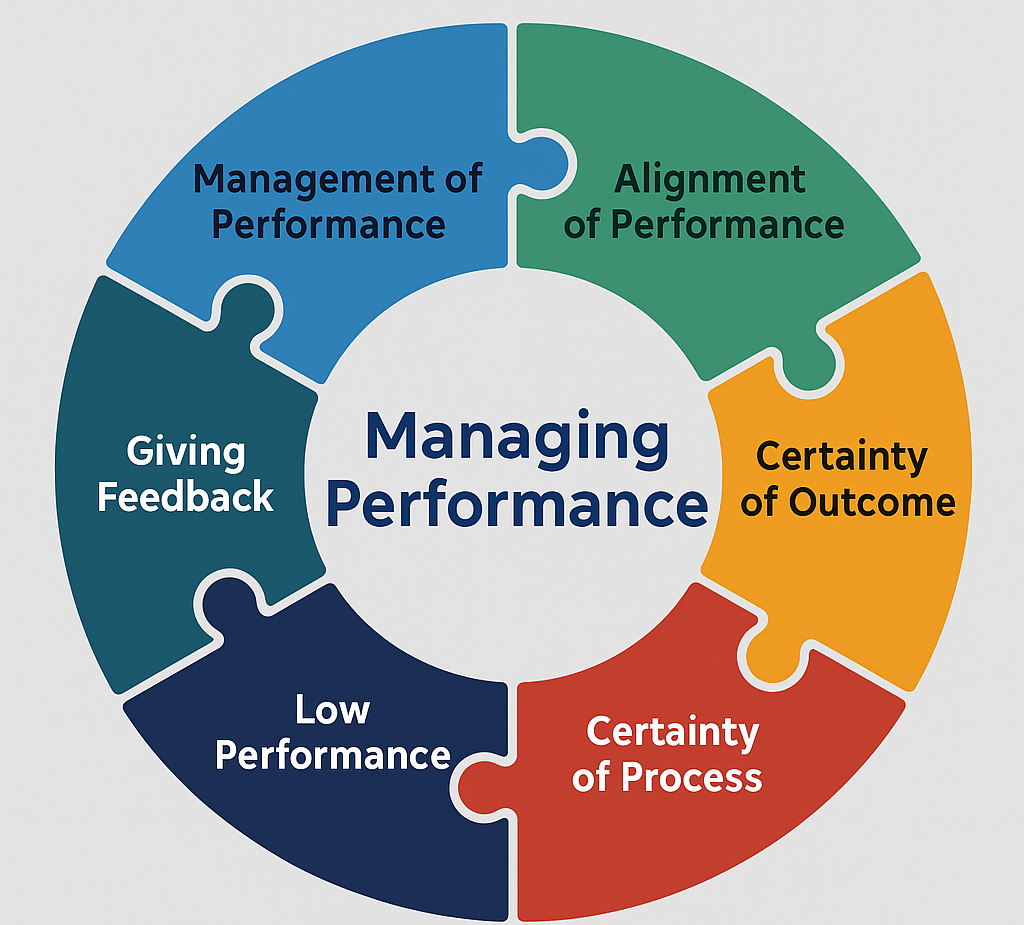Managing performance is one of vital priorities or challenges in any business entity. Human Resource professionals are constantly challenged to undertake this dilemma in the best possible manner. As all managers as people managers, irrespective of their expertise, undoubtedly are exploring how to handle the performance in a given context.
Conventionally, performance management connotes a ‘management’ dimension whereas the emerging demand is to “align’ or rather ‘navigate’ ‘enhance’ in the performance management space. This article sheds light on setting clarity with management of performance vs alignment of performance while bringing some guiding contours to the discussion and practice.

The CEOs constantly get exposed to multitude of business challenges from all fronts. They are in an unprecedent struggle to make the business move to the next level with superior business performance. In this backdrop, more than the HR intervention, CEOs have a concern at a strategic level on how to make their people perform in assigned jobs for intended results better while facing totally unpredictable business environmental demands.
The ‘known’ recipe for driving performance is setting goals and making regular appeals to all employees probably might not be adequate. Under the largely practising method, managers or immediate supervisors may receive additional pressure from the top to perform and make others perform i.e. achieving targets.
In this backdrop, most companies strive to figure out a better or a different way of performance management system to drive performance. Does this make sense? If yes, how could it look like?
What is the conventional approach in managing performance? Setting goals and objectives by the management through top-down or bottom-up mode. Ultimately, employees have some assigned goals and tasks to perform or achieve. As per different approaches and modalities, institutions may have half-yearly or annual dialogues which mainly deal with individual past performance and future. It happens between an individual employee and his/her immediate supervisor.
Typically, there is an annual formal assessment and results of our judgements and decisions supervisor is leading through procedures and common parameters, formats, performance indicators, rules, standards, etc.
These assessments are defined across units and levels of management systems and hierarchies. Ideally, expected results are imminent. Does this generate expected results? The answer is yes and no as well as mixed. This phenomenon requires a deep inquiry into the HR practices in the contemporary rapidly changing business landscape.
It is useful to explore first, the existing key performance indicators-based assessment mechanism as it creates a number of subtleties in supervisor and employee relationship contexts. We primarily set objectives to strive people performance to reduce complexity in work settings. They focus on the few or one factor that matters most. If working well, objectives may distract from other priorities (e.g. overall purpose of the institution).
Objectives when set on an individual basis might lead people to reject teamwork. Once achievement of objectives is linked to variable pay, people may commit themselves to objectives that are easy to achieve only. Objectives, when clearly measured might lead people to start altering and fixing – “you might get what you measure”.
The element of subjectivity and the whole plethora of other complexities are applicable to assess performance in an arbitrary business setting. Even if the people have contributed, their performance may be graded based on contextually driven factors. At the same time, one may argue the fact that there are no other scientific alternatives. So that we may tend to continue the established practice as the “best practice’.
The case is clear that are we ready to continue Structured and top-down method of the performance of our employees is formally assessed once a year or bi-annually by their direct superiors on the basis of structured guidelines.
Otherwise, seeking to move towards a lateral and qualitative approach of assessing (joint) performance continuously and within teams by primarily using qualitative formats but using indicators where it seems reasonable.
The crux of this deliberation is identifying a scientific application to gauge any job based on two key factors. i.e. certainty of outcome and certainty of process to perform a task. It gives profound comprehension about a particular job. It is evident that when the situation of the certainty of the outcome is high, and the certainty of process is also high, employees are engaging in regularly mundane tasks.
Objectives are agreed regularly (annually). This allows synchronisation with other internal processes, which also follow a regular cycle. No intention of undervaluing a particular job. The requirement is to meet the standards and adhering to the compliance.
Key performance indicators may not be appropriate for assessing these jobs. However, we tend to measure these jobs based on KPIs.
On the other hand, the opposite is intriguing. When the certainty of outcome is low as well as the certainty of process is also low means work demands towards an “agile’ approach. It is a demand-oriented approach. Performance expectations can always be defined if they appear to be appropriate for the respective employee.
CEOs and HR professionals face the conundrum under these circumstances. This is where modern management of recognising jobs is getting challenged. The conventional approaches may not be appropriate. KPIs will not meet expectations under these circumstances.
Our HR practices are tested in the way we navigate in this space. Typical KPIs may be detrimental in these circumstances. Probably a contemporary practice like applying OKRs may be a suitable intervention for goal-setting and driving performance.
OKR stands for Objectives and Key Results which became famous through the legendary CEO of Intel Andy Grove. ‘O’ refers to top priorities for teams or entire organisations and they should not be measurable.
‘KR’ refers to interim outcomes on the way towards reaching the goals on individual and group level. While O typically are of long-term and generic nature and KR supposed to be regular adapted on short cycle (executional heartbeat). KR is always ambitious. They are measurable. KR as well as all related initiatives are transparent across units and functions. OKR are a part of the business operating system not considered as separate encounters.
It is our task now to find ways and means to execute this approach under given or emerging scenarios. We have two scenarios, i.e. Individual basis vs team basis. In the individual basis, objectives are agreed individually with each employee. This ensures personal commitment and clear responsibility. Next level manager (vertical) works on the agreement of objectives which always takes place with the next higher manager.
He or she has an overview and bears overall responsibility. The other dimension is team-based. Performance is only achieved by whole teams. This is why performance expectations are only defined with teams as a whole. When it relates to internal and external customers (lateral) teams are primarily committed to their (internal and external) customers.
They are therefore also used to define and set performance expectations. Understanding this paradox requires clarity in our approach in managing people. It demands greater leadership drive and relatively cohesive work culture.
Another interesting dimension is dealing with low performers and low performance. This is one of the complacent factors in the conventional performance management domain. Well-led companies actively deal with low performers and low performance. Low performance should be addressed instantly during an occupational dialogue.
When dealing with low performance a process of reflection should be triggered, and specific solutions should be found to overcome low performance. Most well-led companies either replace low performers internally or lay them off. Annually identification of C-players only makes sense once decisions upon employees (performers) need to be made. There is often no reason to inform medium or regular performers about being a B-Player.
It might just bump off motivation while there are no formal consequences anyway. This is simply due to non-reading low performers vs low performance. That should be carefully navigated rather than messing it up with modern performance management demands.
The gamut of performance deliberation is questioned on the way we handle appraisals and giving feedback. This has created a whole set of puzzles in assessing performance domain. The established dogma is one can’t manage an organisation well without performance appraisal.
Any other mode would mean mess and lack of orientation. It’s one of the most important procedures in human resource management.
Even when it’s painful people treasure it. On the other hand, managers don’t communicate with their people otherwise. At the same time, it is imperative to identify the counterarguments for the performance appraisal which are a complete waste of too much time for everybody.
It does not fit the way we lead and cooperate. People get demotivated by all good intentions. It is a ridiculous idea invented by HR people without any clue. Not having appraisal means nobody will miss it.
On scientific merit to performance evaluation, employees receive feedback primarily from their direct managers. Giving feedback is one of the most important management tasks.
Employees principally ask for feedback from their (internal/external) customers or colleagues. Feedback is external information about past behaviour often used to improve behaviour. Feedback is essential for learning and improvement in any system.
Feedback effectiveness is a matter of the receiver only. There is feedback and social feedback. Feedback can occur on four different levels: Results, Person, Process and Self-regulation. Social feedback is given by another person or group. Feedback effectiveness is determined by the social setting, who gives feedback to whom and why. Feedback might be given by different stakeholders: Supervisor, Peers, Customers.
In many companies there are tools, systems, policies and processes to manage feedback. The question is how many professional managers are handling in the task of feedback on scientific and professional grounds. Particularly, how does appraisal work in agile settings. Importantly, in compliance settings, feedback may be worse if the assessment is driven by KPIs.
In conclusion, I wish to invite HR and all people managers to explore the contemporary performance alignment methodology to make the workplaces to better places with motivated workers. Importantly, let the CEOs believe that HR truly meets their emerging business demands by responding with novel thinking and applications.
After all, performance appraisal is technically dead, making it more viable through effective novel means is need of the hour. The question remains unanswered to what extent HR folks are ready to embrace these grim realities!


